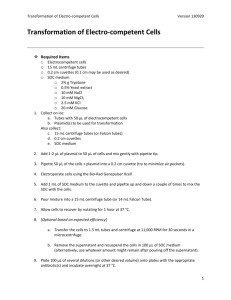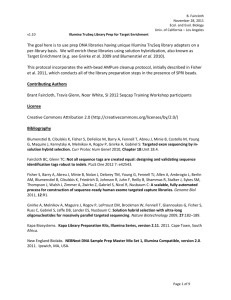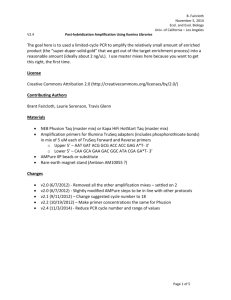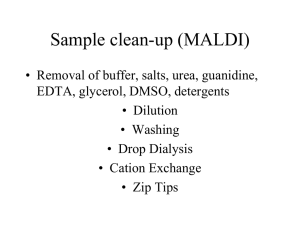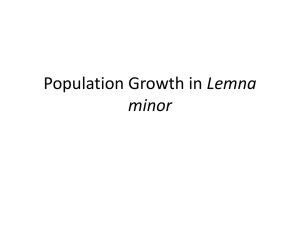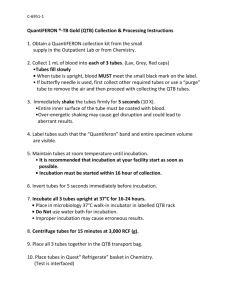Beadcleanup_Protocol
advertisement
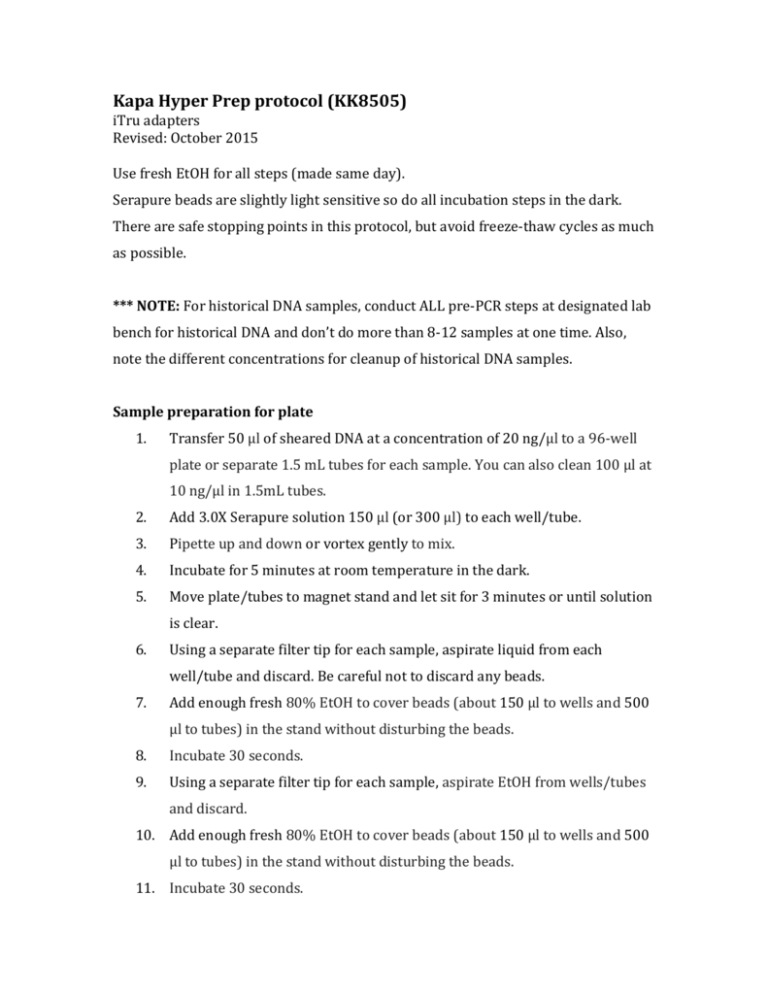
Kapa Hyper Prep protocol (KK8505) iTru adapters Revised: October 2015 Use fresh EtOH for all steps (made same day). Serapure beads are slightly light sensitive so do all incubation steps in the dark. There are safe stopping points in this protocol, but avoid freeze-thaw cycles as much as possible. *** NOTE: For historical DNA samples, conduct ALL pre-PCR steps at designated lab bench for historical DNA and don’t do more than 8-12 samples at one time. Also, note the different concentrations for cleanup of historical DNA samples. Sample preparation for plate 1. Transfer 50 μl of sheared DNA at a concentration of 20 ng/μl to a 96-well plate or separate 1.5 mL tubes for each sample. You can also clean 100 μl at 10 ng/μl in 1.5mL tubes. 2. Add 3.0X Serapure solution 150 μl (or 300 μl) to each well/tube. 3. Pipette up and down or vortex gently to mix. 4. Incubate for 5 minutes at room temperature in the dark. 5. Move plate/tubes to magnet stand and let sit for 3 minutes or until solution is clear. 6. Using a separate filter tip for each sample, aspirate liquid from each well/tube and discard. Be careful not to discard any beads. 7. Add enough fresh 80% EtOH to cover beads (about 150 μl to wells and 500 μl to tubes) in the stand without disturbing the beads. 8. Incubate 30 seconds. 9. Using a separate filter tip for each sample, aspirate EtOH from wells/tubes and discard. 10. Add enough fresh 80% EtOH to cover beads (about 150 μl to wells and 500 μl to tubes) in the stand without disturbing the beads. 11. Incubate 30 seconds. 12. Using a separate filter tip for each sample, aspirate EtOH from wells/tubes and discard. 13. Allow wells/tubes containing Serapure beads to dry for approximately 5 minutes or until there is no longer a smell of EtOH. Once dry, the beads should appear more matte than shiny, but avoid letting them over dry and appear cracked or crusty. Do not dry on a heat block. You can use sterile toothpicks to remove EtOH blobs, which speeds up the drying process. 14. Add 50 μl Elution Buffer (10mM Tris-HCl, pH 8.0) to each well/tube. 15. Pipette up and down or vortex gently to mix. a. If you are continuing onto the library prep protocol on the same day, proceed to the next section. b. If you are storing your samples to begin library prep later, place samples in the freezer (-20˚C) and proceed to step 16. 16. Incubate for 5 minutes at room temperature in the dark. 17. Move plate/tubes to magnet stand and let sit for 3 minutes or until solution is clear. 18. Using a separate filter tip for each sample, aspirate liquid from each well/tube and transfer to a new clean plate or tube. End Repair and A-Tailing NOTE: The following steps can be performed on or off bead depending on if samples were stored after cleaning and prior to library prep. 19. Assemble End Repair and A-Tailing reaction (add 10% for pipette error): 7 μl End Repair and A-Tailing Buffer 3 μl End Repair and A-Tailing Enzyme Mix 20. Add 10 μl End Repair and A-Tailing reaction mix to wells/tubes containing DNA (and beads if applicable) in 50 μl Elution Buffer (resulting in 60 μl total volume). 21. Pipette up and down to mix. 22. Incubate plate in a thermocycler or tubes in a thermomixer with the following program: 20˚C for 30 minutes 65˚C for 30 minutes 4˚C hold Y-yoke Ligation 23. Assemble adapter ligation reaction (add 10% for pipette error): 30 μl Ligation Buffer 10 μl DNA Ligase 5 μl PCR-grade H2O 5 μl y-yoke 24. Add 50 μl ligation mix to wells/tubes containing 60 μl DNA (with beads if applicable), Elution Buffer, and End-Repair and A-Tailing reaction mix (resulting in 110 μl total volume). 25. Pipette up and down to mix. 26. Incubate at 20˚C for 15 minutes in a thermocycler or thermomixer. 27. Add 132 μl Serapure to off bead reactions or PEG to on bead reactions (1.2X) to wells/tubes. *** For hDNA samples add 198 μl Serapure or PEG (1.8X) to tubes. 28. Pipette up and down or vortex gently to mix. 29. Incubate for 5 minutes at room temperature in the dark. 30. Move plate/tubes to magnet stand and let sit for 3 minutes or until solution is clear. 31. Using a separate filter tip for each sample, aspirate liquid from each well/tube and discard. 32. Add enough fresh 80% EtOH to cover beads (about 150 μl to wells and 500 μl to tubes) in the stand without disturbing the beads. 33. Incubate 30 seconds. 34. Using a separate filter tip for each sample, aspirate EtOH from wells/tubes and discard. 35. Add enough fresh 80% EtOH to cover beads (about 150 μl to wells and 500 μl to tubes) in the stand without disturbing the beads. 36. Incubate 30 seconds. 37. Using a separate filter tip for each sample, aspirate EtOH from wells/tubes and discard. 38. Allow wells/tubes containing Serapure beads to dry for approximately 5 minutes or until there is no longer a smell of EtOH. Once dry, the beads should appear more matte than shiny, but avoid letting them over dry and appear cracked or crusty. Do not dry on a heat block. You can use sterile toothpicks to remove EtOH blobs, which speeds up the drying process. 39. Add 50 μl Elution Buffer. We will clean these again. 40. Add 60 μl PEG solution (1.2X) to wells/tubes. *** For hDNA samples add 90 μl PEG solution (1.8X) to tubes. 41. Pipette up and down or vortex gently to mix. 42. Incubate for 5 minutes at room temperature in the dark. 43. Move plate/tubes to magnet stand and let sit for 3 minutes or until solution is clear. 44. Using a separate filter tip for each sample, aspirate liquid from each well/tube and discard. 45. Add enough fresh 80% EtOH to cover beads (about 150 μl to wells and 200 μl to tubes) in the stand without disturbing the beads. 46. Incubate 30 seconds. 47. Using a separate filter tip for each sample, aspirate EtOH from wells/tubes and discard. 48. Add enough fresh 80% EtOH to cover beads (about 150 μl to wells and 200 μl to tubes) in the stand without disturbing the beads. 49. Incubate 30 seconds. 50. Using a separate filter tip for each sample, aspirate EtOH from wells/tubes and discard. 51. Allow wells/tubes containing Serapure beads to dry for approximately 5 minutes or until there is no longer a smell of EtOH. Once dry, the beads should appear more matte than shiny, but avoid letting them over dry and appear cracked or crusty. Do not dry on a heat block. You can use sterile toothpicks to remove EtOH blobs, which speeds up the drying process. 52. Add 33 μl Elution Buffer. 53. Pipette up and down or vortex gently to mix. 54. Incubate for 5 minutes at room temperature in the dark. 55. Move plate to magnet stand and let sit for 3 minutes or until solution is clear. 56. Using a separate filter tip for each sample, aspirate liquid from the wells/tubes and transfer to a new, clean plate or tube. 57. Quantify 2 μl using Qubit HS kit and proceed directly to amplification OR you may wish to Dual-SPRI size select to tighten fragment distribution to your desired range. If you used 500 ng to 1 μg of input DNA, the amount of total DNA you will have in solution should be 50-75% of what you started with. * Safe stopping point: you may store your samples at 4˚C overnight or at -20˚C for longer storage. Dual-SPRI clean-up 58. Add 19.8 μl Serapure (0.6X) to each well/tube containing DNA in 33 μl Elution Buffer (resulting in 52.8 μl total volume). 59. Pipette up and down or vortex gently to mix. 60. Incubate for 5 minutes at room temperature in the dark. 61. While your samples are incubating, add 63.4 μl Serapure (1.2X) to each well of a new, clean plate or new, clean tubes. 62. Move plate/tubes to magnet stand and let sit for 3 minutes or until solution is clear. 63. Transfer supernatant to wells/tubes containing 63.4 μl Serapure (resulting in 116.2 μl total volume). 64. Pipette up and down or vortex gently to mix. 65. Incubate for 5 minutes at room temperature in the dark. 66. Move plate/tubes to magnet stand and let sit for 3 minutes or until solution is clear. 67. Using a separate filter tip for each sample, aspirate liquid from each well/tube and discard. 68. Add enough fresh 80% EtOH to cover beads (about 150 μl to wells and 200 μl to tubes) in the stand without disturbing the beads. 69. Incubate 30 seconds. 70. Using a separate filter tip for each sample, aspirate EtOH from wells/tubes and discard. 71. Add enough fresh 80% EtOH to cover beads (about 150 μl to wells and 200 μl to tubes) in the stand without disturbing the beads. 72. Incubate 30 seconds. 73. Using a separate filter tip for each sample, aspirate EtOH from wells/tubes and discard. 74. Allow wells/tubes containing Serapure beads to dry for approximately 5 minutes or until there is no longer a smell of EtOH. Once dry, the beads should appear more matte than shiny, but avoid letting them over dry and appear cracked or crusty. Do not dry on a heat block. You can use sterile toothpicks to remove EtOH blobs, which speeds up the drying process. 75. Add 33 μl Elution Buffer. 76. Pipette up and down or vortex gently to mix. 77. Incubate for 5 minutes at room temperature in the dark. 78. Move plate/tubes to magnet stand and let sit for 3 minutes or until solution is clear. 79. Using a separate filter tip for each sample, aspirate liquid from each well/tube and transfer to a new, clean plate or tube. 80. Quantify 2 μl using Qubit HS kit. * Safe stopping point: you may store your samples at 4˚C overnight or at -20˚C for longer storage. Library Amplification 81. Assemble the PCR master mix (add 10% for pipette error): 25 μl HiFi Ready Mix 2.5 μl i5 primer (iTru5_01_A) 5 μl H2O 82. Aliquot 32.5 μl PCR master mix into wells of a new, clean 96-well plate or strip tubes. 83. Add 2.5 μl sample-specific i7 primer to each sample well. 84. Add 15 μl ligated DNA to wells (resulting in 50 μl total volume). 85. Pipette up and down to mix. 86. Run the following hot start thermal cycler program (make sure to warm up thermal cycler to 98˚C prior to putting your tubes into the machine): 98˚C for 45 seconds 6-12 cycles of (determine number of cycles based on concentration): 98˚C for 15 seconds 60˚C for 30 seconds 72˚C for 30 seconds 72˚C for 5 minutes 4˚C hold 87. Add 60 μl Serapure (1.2X) to each well or transfer sample into new, clean tubes containing 50 μl Serapure. *** For hDNA samples transfer sample to new, clean tubes containing 90 μl Serapure (1.8X). 88. Pipette up and down or vortex gently to mix. 89. Incubate for 5 minutes at room temperature in the dark. 90. Move plate/tubes to magnet stand and let sit for 3 minutes or until solution is clear. 91. Using a separate filter tip for each sample, aspirate liquid from each well and discard. 92. Add enough fresh 80% EtOH to cover beads (about 150 μl to wells and 200 μl to tubes) in the stand without disturbing the beads. 93. Incubate 30 seconds. 94. Using a separate filter tip for each sample, aspirate EtOH from wells/tubes and discard. 95. Add enough fresh 80% EtOH to cover beads (about 150 μl to wells and 200 μl to tubes) in the stand without disturbing the beads. 96. Incubate 30 seconds. 97. Using a separate filter tip for each sample, aspirate EtOH from wells/tubes and discard. 98. Allow wells/tubes containing Serapure beads to dry for approximately 5 minutes or until there is no longer a smell of EtOH. Once dry, the beads should appear more matte than shiny, but avoid letting them over dry and appear cracked or crusty. Do not dry on a heat block. You can use sterile toothpicks to remove EtOH blobs, which speeds up the drying process. 99. Add 23 μl ddH2O. 100. Pipette up and down to mix. 101. Incubate for 5 minutes at room temperature in the dark. 102. Move plate/tubes to magnet stand and let sit for 3 minutes or until solution is clear. 103. Using a separate filter tip for each sample, aspirate liquid from each well/tube and transfer to a new, clean plate or tube. 104. Quantify 2 μl using the appropriate Qubit kit for your initial sample concentration. You may wish to dual-SPRI size select at this step to tighten fragment distribution to your desired range before proceeding with target enrichment. 105. Store your samples at -20˚C.
